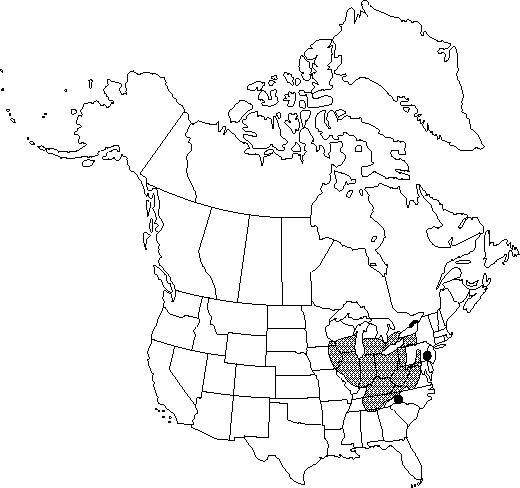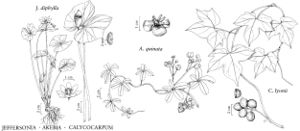Difference between revisions of "Jeffersonia diphylla"
Syn. Pl. 1: 418. 1805.
FNA>Volume Importer |
imported>Volume Importer |
||
| (7 intermediate revisions by 2 users not shown) | |||
| Line 13: | Line 13: | ||
}}{{Treatment/ID/Special_status | }}{{Treatment/ID/Special_status | ||
|code=F | |code=F | ||
| − | |label= | + | |label=Illustrated |
}} | }} | ||
| − | |basionyms={{Treatment/ID/ | + | |basionyms={{Treatment/ID/Basionym |
|name=Podophyllum diphyllum | |name=Podophyllum diphyllum | ||
|authority=Linnaeus | |authority=Linnaeus | ||
| + | |rank=species | ||
| + | |publication_title=Sp. Pl. | ||
| + | |publication_place=1: 505. 1753 | ||
}} | }} | ||
|synonyms= | |synonyms= | ||
| Line 27: | Line 30: | ||
}}<!-- | }}<!-- | ||
| − | --><span class="statement" id="st- | + | --><span class="statement" id="st-undefined" data-properties=""><b>Leaves:</b> petiole slender, erect, 9-25 cm at anthesis, maturing to 18-43 cm. <b>Leaf</b> blade 2-foliolate, often with minute apiculation between leaflets; leaflets 1.2-4 × 0.6-2.5 cm at anthesis, maturing to 6-13 × 3-7 cm, lobes rounded to acute. <b>Scapes</b> 9-33 cm, frequently taller than petioles at anthesis. <b>Flowers</b>: sepals elliptic to obovate, 7-15 × 4-6 mm; petals white, elliptic to obovate, 11-22 × 9-12 mm; stamens 6-12 mm; filaments 2-3 mm; anthers 4-9 × 1-1.5 mm; ovaries 6-11 × 3-7 mm. <b>Fruits</b> 18-38 × 8-17 mm, leathery, opening transversely, apical quarter resembling lid, becoming reflexed. <b>Seeds</b> oblong, 4-7 × 2 mm; aril laciniate, attached at adaxial side of hilum. <b>2n</b> = 12.</span><!-- |
-->{{Treatment/Body | -->{{Treatment/Body | ||
| Line 34: | Line 37: | ||
|elevation=100-800 m | |elevation=100-800 m | ||
|distribution=Ont.;Ala.;Ga.;Ill.;Ind.;Iowa;Ky.;Md.;Mich.;Minn.;N.Y.;N.C.;Ohio;Pa.;Tenn.;Va.;W.Va.;Wis. | |distribution=Ont.;Ala.;Ga.;Ill.;Ind.;Iowa;Ky.;Md.;Mich.;Minn.;N.Y.;N.C.;Ohio;Pa.;Tenn.;Va.;W.Va.;Wis. | ||
| − | |discussion=<p>Plants of Jeffersonia diphylla were used medicinally by Native Americans for treatment of dropsy, gravel and urinary ailments, and for gall and diarrhea, and in poultices for sores and ulcers (D. E. Moermann 1986).</p> | + | |discussion=<p>Plants of <i>Jeffersonia diphylla</i> were used medicinally by Native Americans for treatment of dropsy, gravel and urinary ailments, and for gall and diarrhea, and in poultices for sores and ulcers (D. E. Moermann 1986).</p> |
|tables= | |tables= | ||
|references= | |references= | ||
| Line 43: | Line 46: | ||
-->{{#Taxon: | -->{{#Taxon: | ||
name=Jeffersonia diphylla | name=Jeffersonia diphylla | ||
| − | |||
|authority=(Linnaeus) Persoon | |authority=(Linnaeus) Persoon | ||
|rank=species | |rank=species | ||
| Line 57: | Line 59: | ||
|publication title=Syn. Pl. | |publication title=Syn. Pl. | ||
|publication year=1805 | |publication year=1805 | ||
| − | |special status=Endemic; | + | |special status=Endemic;Illustrated |
| − | |source xml=https:// | + | |source xml=https://bitbucket.org/aafc-mbb/fna-data-curation/src/2e0870ddd59836b60bcf96646a41e87ea5a5943a/coarse_grained_fna_xml/V3/V3_1012.xml |
|genus=Jeffersonia | |genus=Jeffersonia | ||
|species=Jeffersonia diphylla | |species=Jeffersonia diphylla | ||
| − | |||
| − | |||
| − | |||
| − | |||
| − | |||
| − | |||
| − | |||
| − | |||
| − | |||
| − | |||
| − | |||
| − | |||
| − | |||
| − | |||
| − | |||
| − | |||
| − | |||
| − | |||
| − | |||
| − | |||
| − | |||
| − | |||
| − | |||
| − | |||
| − | |||
| − | |||
| − | |||
| − | |||
| − | |||
| − | |||
| − | |||
| − | |||
| − | |||
| − | |||
| − | |||
| − | |||
| − | |||
}}<!-- | }}<!-- | ||
-->[[Category:Treatment]][[Category:Jeffersonia]] | -->[[Category:Treatment]][[Category:Jeffersonia]] | ||
Latest revision as of 21:45, 5 November 2020
Leaves: petiole slender, erect, 9-25 cm at anthesis, maturing to 18-43 cm. Leaf blade 2-foliolate, often with minute apiculation between leaflets; leaflets 1.2-4 × 0.6-2.5 cm at anthesis, maturing to 6-13 × 3-7 cm, lobes rounded to acute. Scapes 9-33 cm, frequently taller than petioles at anthesis. Flowers: sepals elliptic to obovate, 7-15 × 4-6 mm; petals white, elliptic to obovate, 11-22 × 9-12 mm; stamens 6-12 mm; filaments 2-3 mm; anthers 4-9 × 1-1.5 mm; ovaries 6-11 × 3-7 mm. Fruits 18-38 × 8-17 mm, leathery, opening transversely, apical quarter resembling lid, becoming reflexed. Seeds oblong, 4-7 × 2 mm; aril laciniate, attached at adaxial side of hilum. 2n = 12.
Phenology: Flowering early spring; fruiting spring.
Habitat: Rich moist woods to semiopen rocky slopes and outcrops, usually over limestone or other calcareous rocks
Elevation: 100-800 m
Distribution

Ont., Ala., Ga., Ill., Ind., Iowa, Ky., Md., Mich., Minn., N.Y., N.C., Ohio, Pa., Tenn., Va., W.Va., Wis.
Discussion
Plants of Jeffersonia diphylla were used medicinally by Native Americans for treatment of dropsy, gravel and urinary ailments, and for gall and diarrhea, and in poultices for sores and ulcers (D. E. Moermann 1986).
Selected References
None.
